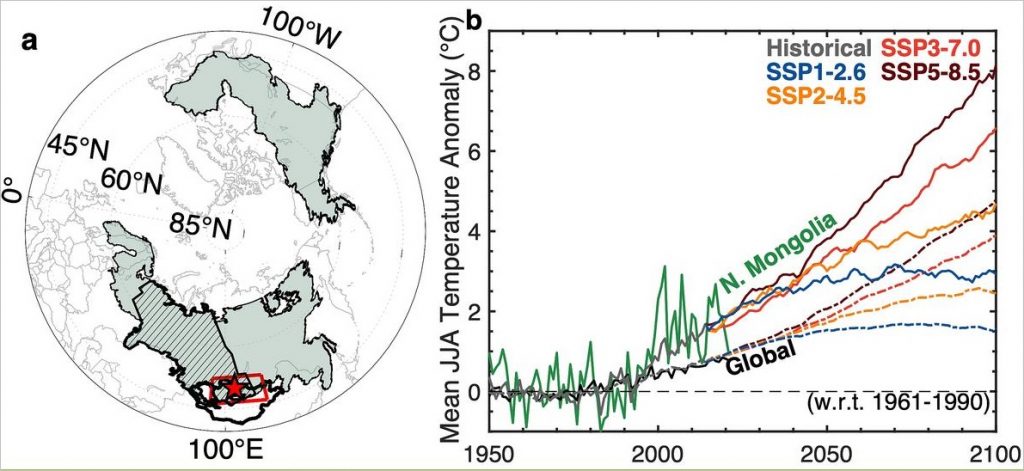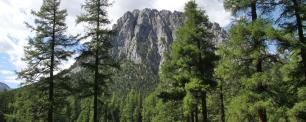The boreal region is heating up 3 times faster than the rest of the planet and its value as a carbon reservoir and guarantor of biodiversity is in danger
Heat waves are causing a rapid increase in temperature throughout the boreal region – the largest biome on the planet – and endanger its forests, which constitutes a third of the world's forest area. The threat posed by climate change to boreal forest is that it limits its ability to absorb carbon dioxide (CO₂) from the atmosphere and thus reduces the carbon sink capacity of an area that is an essential global reservoir. The biome extends across North America and Eurasia. Boreal regions –including northern Mongolia where a recent study has been carried out– have warmed two to three times faster than the rest of the planet, a situation predicted to continue accelerating through this century.
The impact of extreme high temperature on the boreal forest is reported in the scientific article ‘Approaching a thermal tipping point in the Eurasian boreal forest at its southern margin’, recently published in the journal Communications Earth & Environment led by Mukund Rao in collaboration with Laia Andreu-Hayles, both of them CREAF researchers.
The boreal forest is a homogeneous green belt that stores approximately a third of the 450 gigatons of terrestrial carbon and has immense value as a biodiversity guarantor.
The boreal forest is a homogeneous green belt that stores approximately a third of the 450 gigatons of terrestrial carbon and has immense value as a biodiversity guarantor. The scientific work predicts that in 2050 and in a context of high CO₂ emissions, heat waves will dramatically raise the thermometer on the southern margin of the Eurasian boreal forest, in periods that could last between 2 and 3 days above the thermal tolerance range of plant species in the region. The situation is transcendent, because the boreal region of Eurasia significantly determines the percentage of CO₂ in the world atmosphere and, consequently, the global temperature.

“A loss of boreal forest can cause the release of up to 52 gigatons of carbon back into the atmosphere, exacerbating global warming”
MUKUND RAO, CREAF researcher and led author of the study
Additionally, boreal forests provide important services like grazing habitat and timber that will also be threatened.
Climate point of no return
The death of boreal forests constitutes what is called a tipping point in the Earth's system. This means that, once a critical threshold has been exceeded due to the increase in temperature, a small disturbance can drastically and irreversibly change a specific situation. Other examples of tipping points are the disappearance of the Amazon, the melting of the Greenland and West Antarctic ice sheets, and the disappearance of low-latitude coral reefs.
When the thermometers mark between 40 and 50 °C, the leaves of the trees may lose the ability to carry out photosynthesis, by breaking down the protein complexes that facilitate it. Under these conditions it is impossible for them to assimilate carbon dioxide. Although 40 or 50 °C seems like a very high temperature, it must be taken into account that in the summer of 2023 southern Europe has exceeded 40 °C and also that the temperature of the leaves is often above the temperature from air between 5 and 20 °C.

By the end of the 21st century, the boreal forests of the southern margin may experience considerable mortality due to heat waves. They will affect the Siberian larch, 30% of the Eurasian forest biomass and 80% of the Mongolian biomass.
According to the study led by CREAF, by the end of the 21st century it is possible that the boreal forests of the southern margin (Mongolian area) will experience major mortality events due tot the increasing impact of heatwaves associated to climate change. It will basically affect the Siberian larch (Larix sibirica) in the region, a species that represents 30% of the Eurasian forest biomass and 80% of the Mongolian biomass. The obvious result will be the loss of the forest, whose surface will be occupied by herbaceous steppes, gradually and on scales of 50 to 100 years. This time scale (between days and years) is faster than what has been predicted in the sixth assessment report of the Intergovernmental Panel on Climate Change (IPCC) , whose forecast of forest mortality and subsequent ecosystem transition in grasslands is relatively slowly and is quantified decades and centuries.
The scientific article points to the control of global greenhouse gas emissions and local land management as key actions in this context. According to Mukund Rao and Laia Andreu-Hayles, “the most important action is to reduce carbon dioxide emissions. The second is to conduct similar ecophsiological studies in other regions of the boreal forest, to better characterise its vulnerability”.
Reference:
Rao, M.P., Davi, N.K., Magney, T.S., Andreu-Hayles, L. et al. Approaching a thermal tipping point in the Eurasian boreal forest at its southern margin. Commun Earth Environ 4, 247 (2023). https://doi.org/10.1038/s43247-023-00910-6







